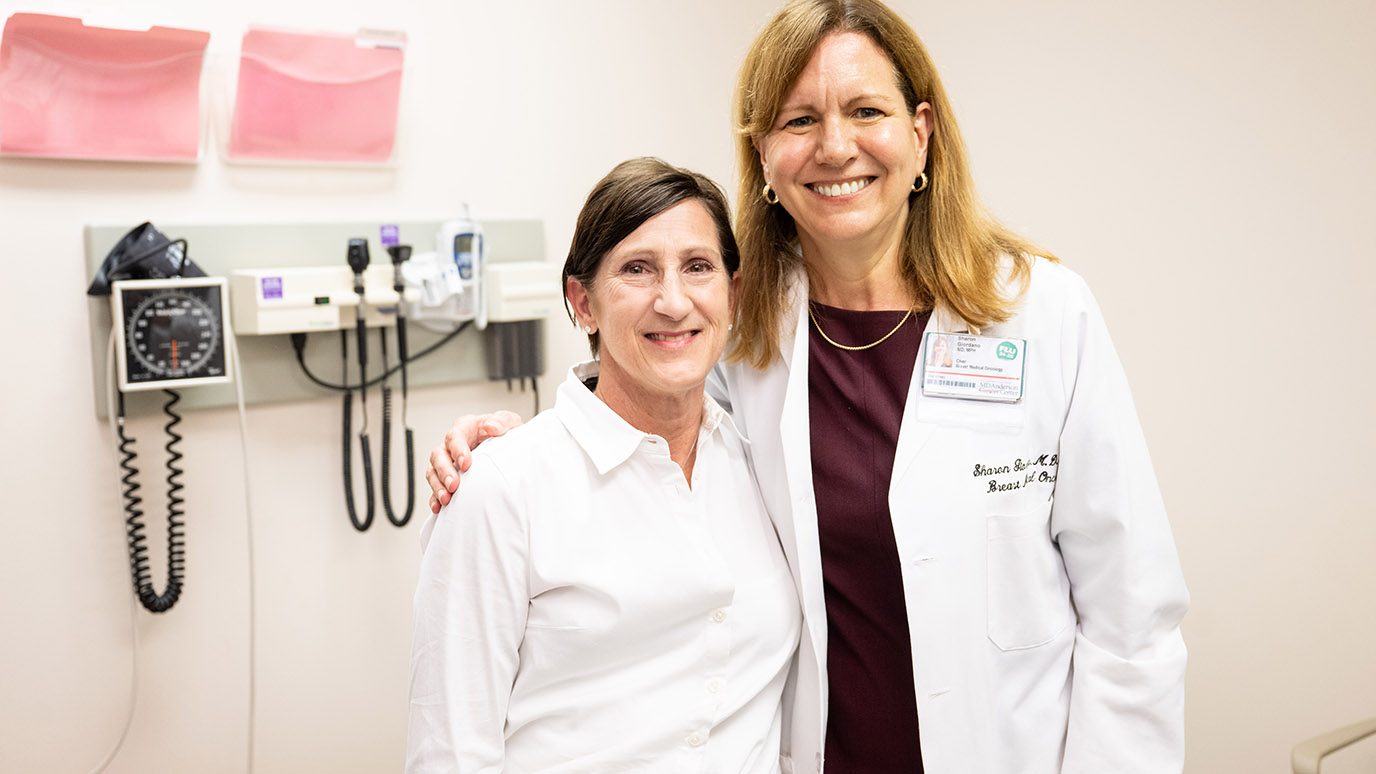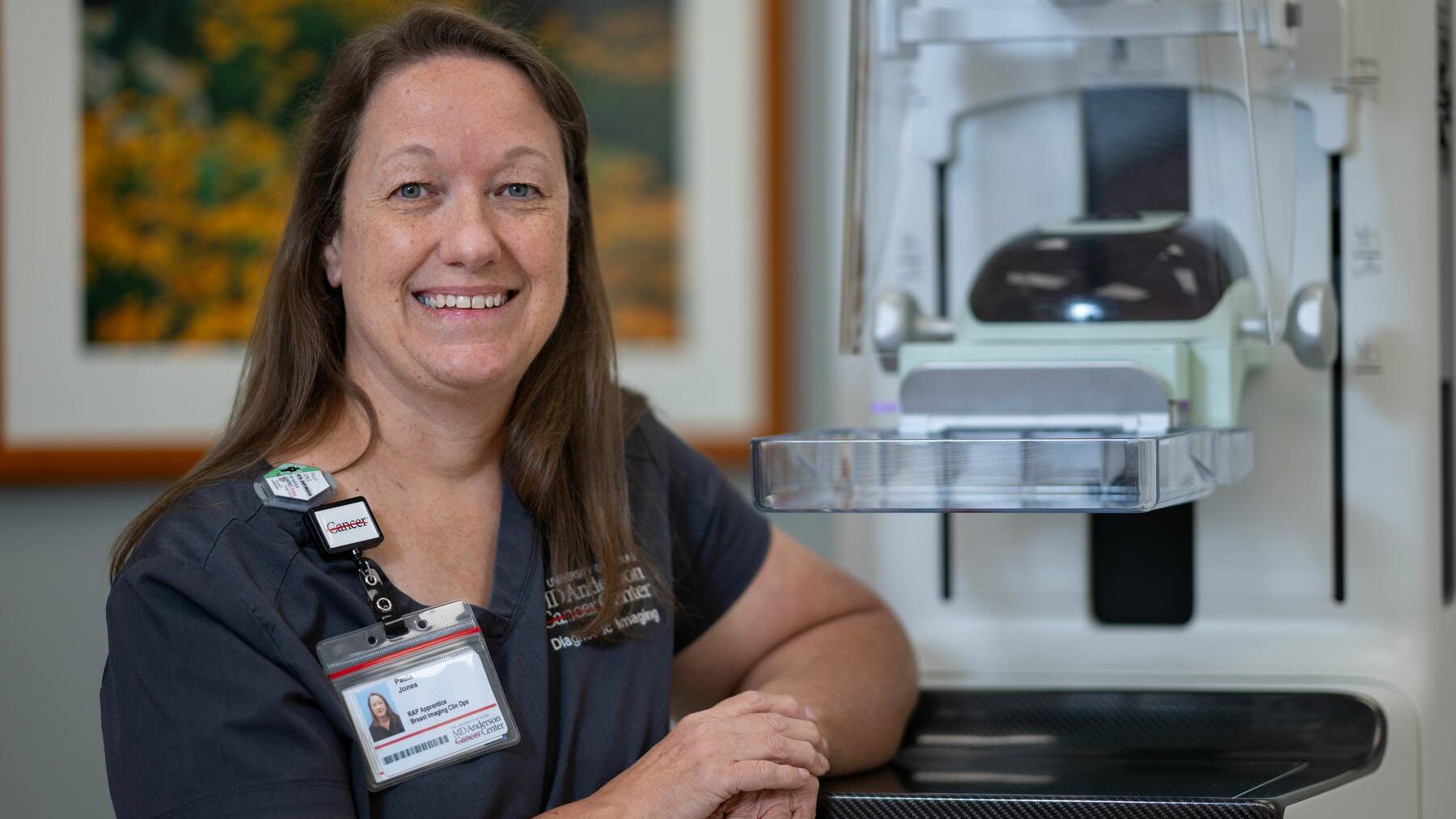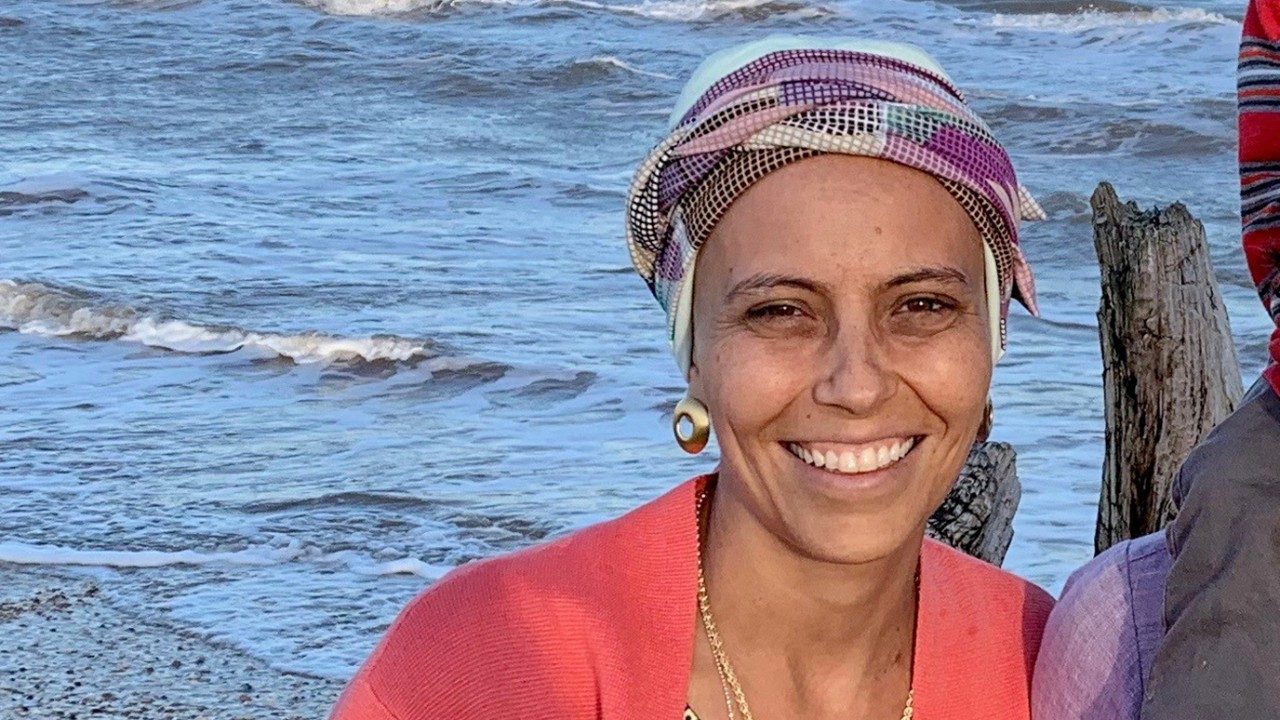request an appointment online.
Get details about our clinical trials that are currently enrolling patients.
View Clinical TrialsTriple-Negative Breast Cancer
What is triple-negative breast cancer?
Triple-negative breast cancer (TNBC) is an aggressive type of breast cancer. About 15% of newly diagnosed breast cancer cases are triple-negative, making it one of the more common forms of the disease.
What does triple-negative mean?
“Triple-negative” refers to the lack of three specific molecules, called receptors, produced by the breast cancer cells.
A cell’s receptors interact or bind with specific proteins and hormones in the body. This is called recognition. Recognition sets many biological processes in motion.
Most breast cancers have at least one of three receptors that fuel the growth and spread of the disease through recognition. These are the HER2 protein and receptors for the hormones estrogen and progesterone.
Doctors treat breast cancers with these receptors with drugs that interrupt recognition. TNBC does not have any of the three receptors. As a result, drugs targeting these receptors do not work on TNBC. Different drugs need to be used.
Triple-negative breast cancer also grows quickly and has a high rate of recurrence, making it one of the most aggressive types of breast cancer.
Triple-negative breast cancer survival rate
Each individual with triple-negative breast cancer is unique and survival rates depend on several factors, including how far the cancer has spread at the time it is found and how the tumor responds to treatment. Overall, the five-year survival rate for patients with TNBC is about 77%. This number does not include women diagnosed in the last few years, who may have received new treatments. The survival rate for current patients may be higher.
Diagnosis, symptoms and risk factors
Triple-negative breast cancer may display similar symptoms as other types of breast cancer. Like other breast cancers, TNBC is diagnosed with imaging exams and a biopsy of the cancer tissue.
Once doctors confirm cancer, they test the biopsy tissue for molecular receptors. If the cancer has no receptors for estrogen and progesterone and does not have high levels of HER2, it is considered triple-negative.
TNBC has many of the same risk factors as other types of breast cancer. One difference is age. Compared to other types of breast cancer, TNBC is more common in women under age 50. Black women are also at an increased risk for the disease.
Triple-negative breast cancer treatment
When triple-negative breast cancer is caught before it has spread to distant parts of the body, it is usually treated with chemotherapy, sometimes in combination with immune checkpoint inhibitors, followed by surgery. Patients may receive radiation therapy after surgery.
Patients may also receive additional chemotherapy or immunotherapy after surgery to kill any remaining cancer cells and reduce the risk of recurrence.
If the disease has spread to distant parts of the body, it can be treated with a variety of cancer drugs. These include immune checkpoint inhibitors, chemotherapy and targeted therapy. In some cases, these patients will receive radiation therapy.
Why Choose MD Anderson for your triple-negative breast cancer treatment?
Choosing the right hospital may be the most important decision you make as a triple-negative breast cancer patient. At MD Anderson, you’ll get treatment from one of the nation’s top-ranked cancer centers.
The surgeons, radiation oncologists and medical oncologists with the Nellie B. Connally Breast Center focus exclusively on curing breast cancer, extending the life of breast cancer patients and maximizing their quality of life.
Among them are many physicians who specialize in treating TNBC. Each doctor brings their skills to our multidisciplinary teams, where they work together to develop treatment plans that address the unique nature of each TNBC case and patient.
If a patient receives both chemotherapy and immunotherapy before surgery, the tumor’s response must be monitored closely. At MD Anderson, our dedicated breast imaging team tracks these tumors with state-of-the-art imaging that provides accurate pictures of the tumor throughout treatment.
As a top-ranked cancer center, we also have one of country’s the largest clinical trials program for triple-negative breast cancer. This includes studies of new treatments and treatment combinations, including clinical trials that are not available anywhere else.
Breast cancer recurrence: Which types of breast cancer are most likely to come back?
Breast cancer recurrence happens when breast cancer comes back after you receive treatment. I often get asked which breast cancer types have the highest rates of disease recurrence.
The answer isn’t so simple. Read on to learn what factors may contribute to breast cancer recurrence and get answers to other common questions I hear about breast cancer recurrence.
Which types of breast cancer are more likely to recur?
All types of breast cancer can recur.
There isn’t one variable that uniquely determines whether breast cancer will come back in a particular patient. Recurrence depends on several factors, including the cancer’s stage, receptor status, the tumor’s response to treatment and compliance with the recommended treatment.
Cancer stage
One of the best predictors of breast cancer recurrence is the cancer’s stage at the time of diagnosis.
In general, the higher the cancer’s stage, the higher the risk for recurrence. So, if you are diagnosed with breast cancer at stage III, there’s a higher chance that the breast cancer will come back compared to being diagnosed with breast cancer at stage I.
However, this doesn’t mean that all stage III breast cancers will eventually recur. And some stage I breast cancers may recur.
Receptor status
The breast cancer’s receptor status subtype may also contribute to recurrence. There are three receptors that we measure in breast cancer: estrogen, progesterone and HER2. Receptor status refers to how these three receptors express in the breast cancer cell: positive or negative. The combination of these three receptors determines the receptor status of each breast cancer and guides doctors on how to treat the disease.
Triple-negative breast cancer (all three receptors are negative) is an aggressive subtype of breast cancer, meaning that the cancer tends to grow rapidly and usually requires chemotherapy.
Inflammatory breast cancer is an aggressive type of cancer that is often triple-negative or HER2 positive. It has a high rate of recurrence.
Treatment
While aggressive breast cancers have a higher risk for recurrence, that’s not always the case.
How you treat the breast cancer initially – including chemotherapy, radiation therapy, the type of surgery and other therapies – as well as how the tumor responds to these treatments can affect your risk for recurrence.
For example, triple-negative breast cancer usually responds well to systemic therapy. So, patients who get chemotherapy with immunotherapy and then have breast surgery and experience a pathological complete response have a lower risk for recurrence than someone who has an estrogen receptor-positive breast cancer that did not respond to therapy.
However, if someone has triple-negative breast cancer and the tumor does not respond after chemotherapy and surgery – or grows larger during chemo, that cancer has a very high risk for recurrence.
How long after treatment does breast cancer come back?
Again, it depends.
We researched the recurrence risk for triple-negative breast cancer after five years from completion of treatment and found that the risk was very low, around 2% to 3%. This is for all stages of triple-negative breast cancer. If you are disease-free at year five, you have a very low risk for recurrence.
HER2 positive breast cancer is like triple-negative breast cancer in that if it does recur, it’s usually in the first five years after treatment.
About 50% of estrogen receptor-positive breast cancer recurrences happen in the first five years. The other 50% of recurrences are after five years. Most recurrences happen in the first 10 years, but it could be further out than that. We’ve had patients who had a recurrence 25 years after treatment, but those cases tend to be rare.
Triple-negative breast cancer survivor: Why I chose a clinical trial at MD Anderson
Cancer runs very strongly on one side of my family. Several members have had either breast cancer or ovarian cancer. Two tested positive for the BRCA1 genetic mutation. So, I knew the odds were pretty high that I carried it, too.
After finding out about the mutation, I put off getting genetic testing for about two years. I didn’t want to know yet.
But I became the first person of my generation in my family to take the plunge. The testing confirmed my fears: I had the BRCA1 mutation. That substantially increased my risk of developing both breast and ovarian cancers. I started getting high-risk breast cancer screenings every six months.
So, I was shocked when I was diagnosed with triple-negative breast cancer at age 34.
My triple-negative breast cancer diagnosis
I’d been told that I had until I was about 40 to start making decisions about whether to have my breasts or ovaries removed to reduce my risk. I was glad, because I wanted to wait until I was finished having children to do so.
But when I had my last check-up about two months after I weaned my son, the scan showed a peanut-sized lump in my right breast. Additional testing revealed it was stage II triple-negative breast cancer.
Why I chose MD Anderson
My relatives didn’t get sick until they were in their 50s. And I’d done everything I was supposed to do, including being proactive on screening. But I still got cancer. I was pretty surprised and frightened. Breast cancer sucks, period. But triple-negative breast cancer makes it feel extra scary, because it’s even harder to treat and has higher rates of recurrence.
I knew from relatives that where you go first for cancer treatment is pretty important. But what clinched my decision to go to MD Anderson was the online research my husband conducted. He quickly discovered that chemotherapy only has about a 50% chance of working against triple-negative breast cancer. We wanted better odds than that.
My triple-negative breast cancer treatment
My husband found a clinical trial at MD Anderson run by breast medical oncologist Dr. Jennifer Litton. He reached out to her for more information. Dr. Litton was not able to take me on as a patient, but she referred me to a colleague who was almost entirely focused on triple-negative breast cancer.
I joined a clinical trial under that doctor and received a PARP inhibitor for six months as a part of her study. For a while, the PARP inhibitor kicked my cancer’s butt. Unfortunately, it also caused me a lot of blood issues, so the doctors had to reduce my dosage.
I didn’t have a complete response to the PARP inhibitor. So, after the clinical trial, I had a double mastectomy, an oophorectomy and a chemotherapy combination called ACT. That acronym stands for doxorubicin hydrochloride (Adriamycin) and cyclophosphamide, followed by paclitaxel (Taxol).
It’s been almost five years now since I finished breast cancer treatment. Assuming I don’t have a recurrence, I will officially show no evidence of disease by summer 2025.
My life today
The clinical trial I joined didn’t work out quite as well for me as I’d hoped. But I made a lot of friends on it. And some of them had a perfect response to it, with no blood issues. I was really happy for them.
I have an 8-month-old baby now, and my son is 7. So, I’m finding ways to cultivate more balance in my life and focusing on the things that matter most: family, friends and community. I’ve learned that waking up every day is not guaranteed. So, I live my life full of gratitude. I am grateful to all the nurses, doctors, surgeons, and staff at MD Anderson who supported me — and do so every day, for thousands of other patients.
Dr. Litton told me that MD Anderson is working on new PARP inhibitors that may cause fewer side effects. That made me feel really good, too. Clearly, I wasn’t the only person who struggled with the one I was on. But if what I went through was helpful for somebody else, then I’m glad I did it.
Right now, my only lingering issues are osteoporosis and dry mouth. Those are no big deal, though, considering I’m still here. I’m just happy to be alive.
If the cancer ever comes back, the new medication Dr. Litton mentioned could be an option for me. It might not save my life, but it could prolong it. And that would be OK.
Request an appointment at MD Anderson online or call 1-877-632-6789.
Clinical Trials
Becoming Our Patient
Get information on patient appointments, insurance and billing, and directions to and around MD Anderson.
Help #EndCancer
Give Now
Donate Blood
Our patients depend on blood and platelet donations.
Shop MD Anderson
Show your support for our mission through branded merchandise.




